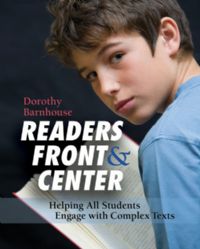Focus on the Reader, Not the Complex Text
Readers Front & Center: Helping All Students Engage with Complex Texts
By Dorothy Barnhouse
(Stenhouse, 2014 – Read more)

Years ago, when I was a very young teacher, I attended a conference where I heard something that has always stuck with me: sometimes, you just need to shut the door and teach. It struck me as absolutely brilliant advice, and I have tried always to adhere to it.
Dorothy Barnhouse, in her book Readers Front and Center, walks the reader through exactly how to do just that. And perhaps partially because of her shared outlook, I loved this book so much that I devoured it in two sittings.
As I read Readers Front & Center, I felt as if I were visiting with a teacher who has faced the same struggles and challenges that we all face and has found some strategies and ideas that work. AND she was spilling her secrets.

One of my favorite things about this book was the clear theme that emerged repeatedly: Teach the student, not the text. Barnhouse says:
Our students need to become the center of our teaching – not the texts, not the standards, and certainly not the assessments.”
By focusing on our students, rather than on the “right” answer or the “right” way to read, we empower ourselves and our students. With all of the current focus on testing, reading seems to be a tail-wagging-the-dog situation; being able to find an answer seems to preclude the importance (and love of!) reading the words on the page.
The power of conferencing
One of the best things that Dorothy Barnhouse does throughout this book is to walk teachers through the concrete steps of how to teach, confer with, and listen to students. She gives specific examples and records sample conversations that show exactly how she accomplishes meaningful conferences with students, even those reluctant readers who seem disconnected from the text they are reading.
Student conferencing constitutes a large portion of this book, and her process is made explicit for the teacher-reader wanting to learn from her example. By conferring with students as they read, we are able to witness the interaction between a student and the words on the page. Additionally, we can discover how our students grasp the material they are reading (or fail to grasp it!), and we get a glimpse of their thinking processes as they read independently.
Barnhouse makes a compelling case for conferencing, stating that discussing even a small selection can provide us with a microcosm of the larger work at plan. She reminds us that the main question that can keep us focused as we confer is this: what can I find out about this student as a reader? By asking that question in all of our interactions, we keep front and center the needs of the student reader, not the need for a right answer to an assessment question.
Correcting is not teaching
One distinction that Barnhouse makes that is worth dwelling on is this: correcting is not teaching. She states:
Correcting is small. It’s about one word, one sentence, one text. Teaching is bigger. It attempts to take that moment and contextualize it. It attempts to help us help our students see the larger work involved and apply it to other texts.”
And at the end of each chapter, she provides a Toolbox section that gives authentic, helpful ways to implement her suggestions. Her ideas are concrete and practical, including sample questions that you might use with students and ways to elicit responses from even reluctant readers.

She continually directs us to remember that students are the ones doing the reading and constructing the meaning, and while we are there for support and guidance, we are not to see ourselves as answer-providers who simply wait in the wings until called on to furnish the correct answer.
Reflecting on practice
As a part of the teaching process, Barnhouse encourages us to reflect regularly and ask ourselves who is doing the bulk of interpreting and understanding the text – the instructors (who clearly have all the answers already) or the students? She summarizes this well by saying:
Our job as teachers of reading is not to teach students The Text, which teaches standardization, but to teach students how to enter a text, absorb it, and experience it. To teach this process, we have to teach for engagement… Transforming your teaching from explaining to listening is a small, deceptively simple step. You can start tomorrow. You don’t have to change your curriculum or units of study or the books you are teaching…you simply have to change how you see your students. If you treat them as meaning makers, they will act like meaning makers.”
In addition to the many helpful, informative notes in the body of the book, the appendices at the end have sample forms that are ready to copy and use with students.
In an early chapter, Barnhouse uses this quotation by Nancy Willard as a chapter opener:
Answers are closed rooms; questions are open doors that invite us in.”
I think that quote summarizes so much of the message this book shares. It shows teachers how to move from those who give answers to teachers who invite students in by opening doors and asking questions. I found this book to be incredibly encouraging and practical and absolutely worth the investment of reading it.
Jenni Miller is a 6th grade Language Arts teacher at Montevideo Middle School in Penn Laird, Virginia. She is in her 20th year of teaching there and absolutely loves reading and writing with her middle school students every day. She also loves Pinterest and frequently pins for middle school teachers and students alike. She can be found at www.pinterest.com/jmillermms


































